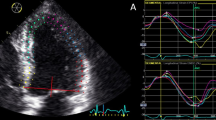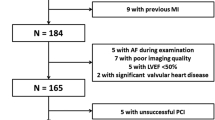Abstract
Purpose
This study aimed to determine if layer-specific strain (LSS) can be used to evaluate and predict left ventricular (LV) recovery in patients with multi-vessel coronary artery disease (CAD) undergoing hybrid coronary revascularization (HCR) using speckle tracking echocardiography (STE).
Methods
A total of 187 consecutive CAD patients who received HCR in our hospital were prospectively enrolled. 30 healthy individuals with matched age and gender were enrolled as a control group. Echocardiography was performed for CAD patients before and 1, 2, and 6 months after HCR. Comprehensive conventional and LSS echocardiography parameters were collected. LV recovery was defined as improvement in LV ejection fraction (LVEF) > 5% at 6-months follow-up compared with baseline. Logistic regression analysis was used to test the correlates of LV recovery. Receiver operating characteristic curve analysis was used to determine the optimal cutoff value of correlates for predicting LV recovery.
Results
LVEF and LV strain in CAD patients were significantly decreased compared with control subjects. Endocardial global longitudinal strain (Endo-GLS) improved significantly at 1-month follow-up (14.2 ± 1.6% vs. 13.8 ± 1.5%, P < 0.05), and LVGLS and global circumferential strain (GCS) improved significantly at 2-months follow-up. Multivariate regression revealed that Endo-GLS, GLS, and SYNTAX score before HCR were independently correlated to LV recovery. Endo-GLS had an optimal cutoff value of 13.2% for predicting LV recovery with sensitivity of 91% and specificity of 78%.
Conclusion
LV myocardial systolic function in CAD patients was impaired before HCR and significantly improved after HCR. Endo-GLS was independently correlated to and has optimal predictive value for LV recovery.


Similar content being viewed by others
References
Neumann F, Sousa-Uva M, Ahlsson A et al (2019) 2018 ESC/EACTS Guidelines on myocardial revascularization. Eur Heart J 40(2):87–165. https://doi.org/10.1093/eurheartj/ehy394
Saha T, Naqvi SY, Goldberg S (2018) Hybrid Revascularization: A Review. Cardiology 140(1):35–44. https://doi.org/10.1159/000488190
Shen L, Hu S, Wang H et al (2013) One-Stop Hybrid Coronary Revascularization Versus Coronary Artery Bypass Grafting and Percutaneous Coronary Intervention for the Treatment of Multivessel Coronary Artery Disease. J Am Coll Cardiol 61(25):2525–2533. https://doi.org/10.1016/j.jacc.2013.04.007
Harskamp RE, Vassiliades TA, Mehta RH et al (2015) Comparative Effectiveness of Hybrid Coronary Revascularization vs Coronary Artery Bypass Grafting. J Am Coll Surgeons 221(2):326–334. https://doi.org/10.1016/j.jamcollsurg.2015.03.012
Kitahara H, Hirai T, McCrorey M et al (2019) Hybrid coronary revascularization: Midterm outcomes of robotic multivessel bypass and percutaneous interventions. J Thorac Cardiovasc Surg 157(5):1829–1836. https://doi.org/10.1016/j.jtcvs.2018.08.126
Smiseth OA, Torp H, Opdahl A et al (2016) Myocardial strain imaging: how useful is it in clinical decision making? Eur Heart J 37(15):1196–1207. https://doi.org/10.1093/eurheartj/ehv529
Geyer H, Caracciolo G, Abe H et al (2010) Assessment of Myocardial Mechanics Using Speckle Tracking Echocardiography: Fundamentals and Clinical Applications. J Am Soc Echocardiog 23(4):351–369. https://doi.org/10.1016/j.echo.2010.02.015
Reimer KA, Lowe JE, Rasmussen MM, Jennings RB (1977) The wavefront phenomenon of ischemic cell death. 1. Myocardial infarct size vs duration of coronary occlusion in dogs. Circulation 56(5):786–794. https://doi.org/10.1161/01.cir.56.5.786
Reimer KA, Jennings RB (1979) The “wavefront phenomenon” of myocardial ischemic cell death. II. Transmural progression of necrosis within the framework of ischemic bed size (myocardium at risk) and collateral flow. Lab Invest 40(6):633–644
Adamu U, Schmitz F, Becker M et al (2008) Advanced speckle tracking echocardiography allowing a three-myocardial layer-specific analysis of deformation parameters. Eur J Echocardiography 10(2):303–308. https://doi.org/10.1093/ejechocard/jen238
Rimbaş RC, Mihăilă-Baldea S, Magda L et al (2020) New Myocardial Deformation by 2D Multi-layer Speckle-Tracking Analysis in Healthy Patients: Normal Reference Values and Their Physiologic Determinants. Ultrasound Med Biol. https://doi.org/10.1016/j.ultrasmedbio.2019.12.001
Skaarup KG, Iversen A, Jorgensen PG et al (2018) Association between layer-specific global longitudinal strain and adverse outcomes following acute coronary syndrome. Eur Heart J Cardiovasc Imaging;19(12):1334-42. https://doi.org/10.1093/ehjci/jey004
Grove GL, Pedersen S, Olsen FJ et al (2021) Layer-specific global longitudinal strain obtained by speckle tracking echocardiography for predicting heart failure and cardiovascular death following STEMI treated with primary PCI. Int J Cardiovasc Imaging 37(7):2207–2215. https://doi.org/10.1007/s10554-021-02202-6
Espersen C, Modin D, Hoffmann S et al (2022) Layer-specific and whole wall global longitudinal strain predict major adverse cardiovascular events in patients with stable angina pectoris. Int J Cardiovasc Imaging 38(1):131–140. https://doi.org/10.1007/s10554-021-02382-1
Tanaka T, Seto S, Yamamoto K et al (2013) An assessment of risk factors for the complexity of coronary artery disease using the SYNTAX score. Cardiovasc Interv Ther 28(1):16–21. https://doi.org/10.1007/s12928-012-0112-5
Sianos G, Morel MA, Kappetein AP et al (2005) The SYNTAX Score: an angiographic tool grading the complexity of coronary artery disease. Eurointervention 1(2):219–227
Lang RM, Badano LP, Mor-Avi V et al (2015) Recommendations for Cardiac Chamber Quantification by Echocardiography in Adults: An Update from the American Society of Echocardiography and the European Association of Cardiovascular Imaging. J Am Soc Echocardiog 28(1):1–39. https://doi.org/10.1016/j.echo.2014.10.003
Meimoun P, Abdani S, Stracchi V et al (2020) Usefulness of Noninvasive Myocardial Work to Predict Left Ventricular Recovery and Acute Complications after Acute Anterior Myocardial Infarction Treated by Percutaneous Coronary Intervention. J Am Soc Echocardiog 33(10):1180–1190. https://doi.org/10.1016/j.echo.2020.07.008
Sciagra R, Sestini S, Bolognese L et al (2002) Comparison of Dobutamine Echocardiography and 99mTc-Sestamibi Tomography for Prediction of Left Ventricular Ejection Fraction Outcome After Acute Myocardial Infarction Treated with Successful Primary Coronary Angioplasty. The Journal of nuclear medicine (1978);43(1):8–14
Meimoun P, Abouth S, Clerc J et al (2015) Usefulness of two-dimensional longitudinal strain pattern to predict left ventricular recovery and in-hospital complications after acute anterior myocardial infarction treated successfully by primary angioplasty. J Am Soc Echocardiogr;28(11):1366-75. https://doi.org/10.1016/j.echo.2015.07.022
Hannan EL, Wu Y, Cozzens K et al (2020) Hybrid Coronary Revascularization Versus Conventional Coronary Artery Bypass Surgery. Circulation: Cardiovasc Interventions 13(10). https://doi.org/10.1161/CIRCINTERVENTIONS.120.009386
Moreno PR, Stone GW, Gonzalez-Lengua CA, Puskas JD (2020) The Hybrid Coronary Approach for Optimal Revascularization: JACC Review Topic of the Week. J Am Coll Cardiol 76(3):321–333. https://doi.org/10.1016/j.jacc.2020.04.078
Hu S, Li Q, Gao P et al (2011) Simultaneous Hybrid Revascularization Versus Off-Pump Coronary Artery Bypass for Multivessel Coronary Artery Disease. Ann Thorac Surg 91(2):432–438. https://doi.org/10.1016/j.athoracsur.2010.10.020
Puskas JD, Halkos ME, DeRose JJ et al (2016) Hybrid Coronary Revascularization for the Treatment of Multivessel Coronary Artery Disease: A Multicenter Observational Study. J Am Coll Cardiol 68(4):356–365. https://doi.org/10.1016/j.jacc.2016.05.032
Reicher B, Poston RS, Mehra MR et al (2008) Simultaneous “hybrid” percutaneous coronary intervention and minimally invasive surgical bypass grafting: Feasibility, safety, and clinical outcomes. Am Heart J 155(4):661–667. https://doi.org/10.1016/j.ahj.2007.12.032
Li D, Guo Y, Gao Y et al (2021) One-Stop Hybrid Coronary Revascularization Versus Off-Pump Coronary Artery Bypass Grafting in Patients With Multivessel Coronary Artery Disease. Front Cardiovasc Med 8:755797. https://doi.org/10.3389/fcvm.2021.755797
Amzulescu MS, De Craene M, Langet H et al (2019) Myocardial strain imaging: review of general principles, validation, and sources of discrepancies. Eur Heart J - Cardiovasc Imaging 20(6):605–619. https://doi.org/10.1093/ehjci/jez041
Becker M, Lenzen A, Ocklenburg C et al (2008) Myocardial Deformation Imaging Based on Ultrasonic Pixel Tracking to Identify Reversible Myocardial Dysfunction. J Am Coll Cardiol 51(15):1473–1481. https://doi.org/10.1016/j.jacc.2007.10.066
van Slochteren FJ, van der Spoel TIG, Hansen HHG et al (2014) Layer-Specific Radiofrequency Ultrasound-Based Strain Analysis in a Porcine Model of Ischemic Cardiomyopathy Validated by a Geometric Model. Ultrasound Med Biol 40(2):378–388. https://doi.org/10.1016/j.ultrasmedbio.2013.09.030
Ono S, Waldman LK, Yamashita H et al (1995) Effect of coronary artery reperfusion on transmural myocardial remodeling in dogs. Circulation;91(4):1143-53. https://doi.org/10.1161/01.cir.91.4.1143
Meimoun P, Abouth S, Clerc J et al (2015) Usefulness of Two-Dimensional Longitudinal Strain Pattern to Predict Left Ventricular Recovery and In-Hospital Complications after Acute Anterior Myocardial Infarction Treated Successfully by Primary Angioplasty. J Am Soc Echocardiog;28(11):1366-75. https://doi.org/10.1016/j.echo.2015.07.022
Park YH, Kang S, Song J et al (2008) Prognostic Value of Longitudinal Strain After Primary Reperfusion Therapy in Patients with Anterior-wall Acute Myocardial Infarction. J Am Soc Echocardiog;21(3):262-7. https://doi.org/10.1016/j.echo.2007.08.026
Ohara Y, Hiasa Y, Hosokawa S et al (2007) Usefulness of Ultrasonic Strain Measurements to Predict Regional Wall Motion Recovery in Patients With Acute Myocardial Infarction After Percutaneous Coronary Intervention. Am J Cardiol 99(6):754–759. https://doi.org/10.1016/j.amjcard.2006.10.030
Kwon DH, Asamoto L, Popovic ZB et al (2014) Infarct characterization and quantification by delayed enhancement cardiac magnetic resonance imaging is a powerful independent and incremental predictor of mortality in patients with advanced ischemic cardiomyopathy. Circ Cardiovasc Imaging 7(5):796–804. https://doi.org/10.1161/CIRCIMAGING.114.002077
Becker M, Altiok E, Lente C et al (2011) Layer-specific analysis of myocardial function for accurate prediction of reversible ischaemic dysfunction in intermediate viability defined by contrast-enhanced MRI. Heart;97(9):748–56. https://doi.org/10.1136/hrt.2010.210906
Acknowledgements
We thank all participants in this study and colleagues for their heap.
Funding
This work was supported by Beijing Municipal Administration of Hospitals Incubating Program (No. XMLX201827).
Author information
Authors and Affiliations
Contributions
XiuZhang Lu and YiDan Li designed the experiment.
Zhe Jiang, Miao Zhang, and YunYun Qin recruited patients.
Zhe Jiang analyzed data.
Zhe Jiang wrote the article.
XiuZhang lu and YiDan Li revised it.
Corresponding author
Ethics declarations
Competing interests
The authors have no relevant financial or non-financial interests to disclose.
Ethics approval
This study was performed in line with the principles of the Declaration of Helsinki. Approval was granted by the Ethics Committee of Capital Medical University (No. 2017-department-196).
Consent to participate
Informed consent was obtained from all individual participants included in the study.
Consent to publish
this manuscript doesn’t contain any individual details, images or videos.
Conflict of interest
There are no conflicts of interest.
Additional information
Publisher’s Note
Springer Nature remains neutral with regard to jurisdictional claims in published maps and institutional affiliations.
Rights and permissions
Springer Nature or its licensor (e.g. a society or other partner) holds exclusive rights to this article under a publishing agreement with the author(s) or other rightsholder(s); author self-archiving of the accepted manuscript version of this article is solely governed by the terms of such publishing agreement and applicable law.
About this article
Cite this article
Jiang, Z., Zhang, M., Qin, Y. et al. Usefulness of layer-specific strain for evaluating and predicting recovery of left ventricular myocardial function in patients undergoing hybrid coronary revascularization. Int J Cardiovasc Imaging 39, 491–499 (2023). https://doi.org/10.1007/s10554-022-02746-1
Received:
Accepted:
Published:
Issue Date:
DOI: https://doi.org/10.1007/s10554-022-02746-1




